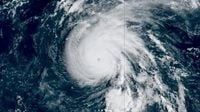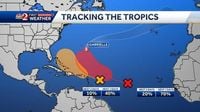Hurricane Gabrielle, the second major hurricane of the 2025 Atlantic season, exploded in strength over the weekend, catching the attention of meteorologists and coastal communities alike. According to the National Hurricane Center (NHC), Gabrielle underwent a dramatic transformation, rapidly intensifying from a Category 1 to a Category 3 hurricane in just 24 hours—a pace that far exceeded the benchmark for rapid intensification, which is defined as a 35 mph increase in wind speed over the same period. Gabrielle’s winds jumped by 55 mph, reaching sustained speeds of 120 mph by Monday morning, September 22, 2025, as reported by CNN and FOX Weather.
The hurricane’s location—about 195 miles southeast of Bermuda on Monday morning—meant that the island narrowly avoided a direct hit. The NHC’s forecast, echoed by FOX Weather and NJ.com, predicted that Gabrielle would skirt to the east of Bermuda, sparing the island from the worst of the storm but still subjecting it to rough surf, gusty winds, and periods of rain. The hurricane was moving north at around 10 mph and was expected to turn more northeastward by Tuesday, passing east of Bermuda on Monday evening.
While Bermuda braced for the storm’s outer effects, the impacts of Gabrielle were felt far beyond its immediate vicinity. The NHC warned that the hurricane’s powerful swells had already reached the U.S. East Coast, from North Carolina northward, and would continue to impact beaches through the first half of the week. These swells were expected to generate life-threatening surf and rip current conditions, prompting officials to urge beachgoers to check local marine forecasts before venturing into the water. FOX Weather highlighted that the dangerous surf would also extend to Atlantic Canada, with the potential for hazardous conditions persisting for several days.
Gabrielle’s rapid intensification was not just a meteorological curiosity—it also served as a stark reminder of the changing nature of hurricanes in a warming world. As CNN noted, rapid intensification events have become more frequent in recent years, a trend that scientists attribute to rising ocean temperatures fueled by fossil fuel pollution. The hurricane’s sudden leap in strength underscored the challenges forecasters face in predicting storm behavior, especially during the peak of the Atlantic hurricane season.
The 2025 season, which runs from June 1 to November 30, had been unusually quiet up to this point. Typically, four or five hurricanes would have formed by late September, but only two—Erin and Gabrielle—had reached hurricane status so far, both of which became major hurricanes. Gabrielle’s arrival as a major hurricane was considered slightly late for the season’s second such storm, but the NHC and various news outlets stressed that the season was far from over, especially as September marks the traditional peak of hurricane activity.
Looking ahead, the Atlantic basin was showing signs of renewed activity. The NHC was tracking two additional areas of disturbed weather with the potential to develop into tropical depressions or storms in the coming days. The first, located in the central tropical Atlantic between the Lesser Antilles and the Cabo Verde Islands, was steadily organizing and had a high chance of strengthening into a tropical depression or tropical storm by mid to late week. Environmental conditions were becoming more favorable, and if the system developed, it would be named Humberto or Imelda, the next names on the 2025 list. FOX Weather quoted the NHC: “Environmental conditions are forecast to become more favorable for development by tomorrow, and a tropical depression is likely to form by the middle to latter part of this week while the system moves west-northwestward to northwestward across the central Atlantic.”
The second area, about 400 miles east of the Lesser Antilles, was less organized and had a medium chance of development later in the week. This disturbance was expected to sweep across the Leeward Islands early in the week with bursts of gusty rain and wind, even if it did not become a fully-fledged tropical system. The NHC and Fox35 Orlando both noted that this system could either fizzle out near the Bahamas or, if conditions allowed, follow a path similar to Hurricane Erin, paralleling the U.S. East Coast.
Despite the lack of direct threats to the U.S. mainland or Florida from Gabrielle itself, the broader impacts of the hurricane season were being felt up and down the Atlantic coastline. The hazardous surf and rip currents generated by Gabrielle were a reminder that even storms that remain far offshore can pose significant dangers to coastal communities. The NHC repeatedly emphasized the importance of vigilance: “Beachgoers should check local marine forecasts before heading into the water this week.”
As for Bermuda, while the island remained outside the hurricane’s direct path, the NHC advised residents to monitor Gabrielle’s progress closely. Swells, showers, and gusty winds would continue to affect the island for several days, with the risk of hazardous conditions persisting even as the storm moved away. No coastal watches or warnings were in effect as of Sunday evening, but the situation was being monitored closely as Gabrielle continued to strengthen.
The Atlantic hurricane season’s slow start had lulled some into a false sense of security, but Gabrielle’s sudden intensification and the emergence of new disturbances served as a wake-up call. As September’s peak continued, meteorologists and emergency officials urged the public to remain prepared for rapidly changing conditions. The NHC’s ongoing advisories and the close attention of outlets like CNN, FOX Weather, and NJ.com ensured that the latest information was widely available, helping communities stay informed and ready to respond.
With Gabrielle’s story still unfolding and new storms potentially on the horizon, the 2025 Atlantic hurricane season was proving that nature’s unpredictability remains a force to be reckoned with. The lessons of Gabrielle—its rapid intensification, far-reaching impacts, and the importance of preparedness—were resonating across the Atlantic, reminding everyone that vigilance is key as the season enters its most active phase.



